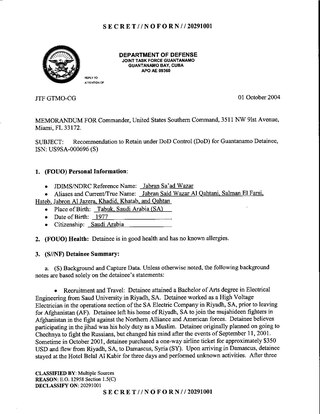
Jabran Said Bin Wazir al-Qahtani is a Saudi who was held in extrajudicial detention for almost fifteen years in the United States Guantanamo Bay detention camps, in Cuba. Joint Task Force Guantanamo analysts estimate he was born in 1977, in Tabuk, Saudi Arabia.
Saeed Ahmed Mohammed Abdullah Sarem Jarabh is a citizen of Yemen who was held in extrajudicial detention for over fourteen years in the United States Guantanamo Bay Naval Base, in Cuba. Joint Task Force Guantanamo analysts estimate he was born in 1976 in Jeddah, Saudi Arabia.

Jabir Jubran Al Fayfi is a citizen of Saudi Arabia who was held in extrajudicial detention in the United States Guantánamo Bay detention camp, in Cuba on allegations he trained and fought with al-Qaeda and the Taliban in Afghanistan in 2001.

Said Salih Said Nashir is a citizen of Yemen, held in extrajudicial detention in the United States Guantanamo Bay detainment camps, in Cuba. His Internment Serial Number is 841.
Abd al Razaq Abdallah Hamid Ibrahim al Sharikh is a citizen of Saudi Arabia who was held in extrajudicial detention in the United States Guantanamo Bay detainment camps, in Cuba.
Sami Abdul Aziz Salim Allaithy Alkinani is an Egyptian professor who was held in the Guantanamo Bay detention camps, in Cuba. His Guantanamo Internment Serial Number was 287. Analysts reported that he was born on October 28, 1956, in Shubrakass Egypt. He was repatriated to Egypt on September 30, 2005. He was later classified by the United States Department of Defense as a no longer enemy combatant.

Yussef Mohammed Mubarak al-Shihri (1985–2009) was a citizen of Saudi Arabia who was held in extrajudicial detention in the United States's Guantanamo Bay detention camps, in Cuba. He was born on September 8, 1985, in Riyadh Saudi Arabia.

Ghaleb Nassar Al Bihani is a citizen of Yemen formerly held in the United States Guantanamo Bay detainment camps, in Cuba. The Department of Defense estimate that he was born in 1979, in Tabuk, Saudi Arabia.

Othman Ahmed Othman Al Omairah was a citizen of Saudi Arabia who was held in extrajudicial detention in the United States Guantanamo Bay detainment camps, Cuba.

Fayiz Ahmad Yahia Suleiman is a citizen of Yemen who was held without charge in the Guantanamo Bay detention camps, in Cuba for 14 years and 160 days. He was transferred to Italy on July 10, 2016.

Mashur Abdallah Muqbil Ahmed Al Sabri is a citizen of Yemen who was held in extrajudicial detention in the United States Guantanamo Bay detainment camps, in Cuba until April 16, 2016. Al Sabri's Guantanamo detainee ID number is 324.
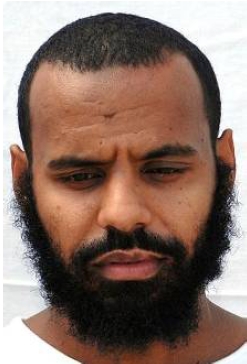
Salem Ahmed Hadi Bin Kanad is a citizen of Yemen, who was held in extrajudicial detention in the United States Guantanamo Bay detainment camps, in Cuba. His detainee ID number is 131. Joint Task Force Guantanamo counter-terrorism analysts reports that Hadi was born on January 15, 1976, in Hadhramaut, Yemen.
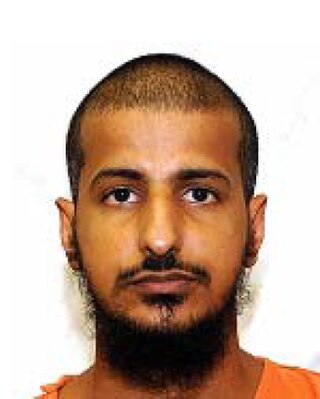
Tarek Ali Abdullah Ahmed Baada is a citizen of Yemen, who was formerly held in extrajudicial detention in the United States Guantanamo Bay detainment camps, in Cuba. His detainee ID number is 178. Joint Task Force Guantanamo counter-terrorism analysts estimated that Baada was born in 1978 in Shebwa, Yemen.
Turki Mash Awi Zayid Al Asiri was a citizen of Saudi Arabia who was held in extrajudicial detention in the United States's Guantanamo Bay detention camps, in Cuba. His Guantanamo Internment Serial Number was 185. Joint Task Force Guantanamo counter-terrorism analysts reports that Al Asiri was born on March 8, 1975, in Yaboq, Saudi Arabia.

Ayman Saeed Abdullah Batarfi is a Yemeni doctor who was held in extrajudicial detention in the United States Guantanamo Bay detention camps, in Cuba. His Guantanamo Internment Serial Number was 627.
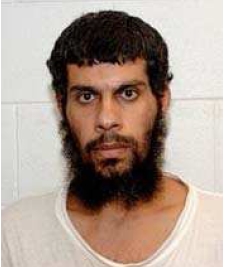
Mohammed Rajab Sadiq Abu Ghanim was held in extrajudicial detention in the United States Guantanamo Bay detention camps, in Cuba, for almost fifteen years. His Guantanamo Internee Security Number is 44. He was eventually transferred to Saudi Arabia

Sa'id Ali Jabir Al Khathim Al Shihri (1971–2013) was a Saudi Arabian deputy leader of the terrorist group Al-Qaeda in the Arabian Peninsula (AQAP), and possibly involved in the kidnappings and murders of foreigners in Yemen. Said Ali al-Shihri was captured at the Durand Line, in December 2001, and was one of the first detainees held at the Guantanamo Bay detention camps, in Cuba, arriving on 21 January 2002. He was held in extrajudicial detention in American custody for almost six years. Following his repatriation to Saudi custody he was enrolled in a rehabilitation and reintegration program. Following his release, he traveled to Yemen.
Periodically Saudi Arabia's Ministry of Interior publishes a most wanted list. According to Asharq Alawsat Saudi Arabia has published four lists of "most wanted" suspected terrorists, and those lists contained 19, 26, 36 and 85 individuals.
Batch 10 is a name journalists have given to the tenth batch of former Saudi captives to be repatriated to Saudi Arabian custody. Five of the fourteen captives in this group repatriated to Saudi captivity on November 9, 2007 were among the eleven former Guantanamo captives to be listed on the 85 men on the Saudi list of most wanted suspected terrorists, published on February 3, 2009. One of the cohort, Said Ali al-Shihri, became second in command of Al Qaeda in the Arabian Peninsula.
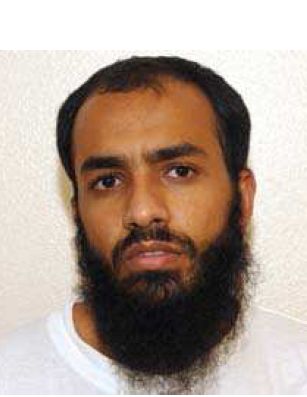
Muhammaed Yasir Ahmed Taher was a citizen of Yemen, who was held in extrajudicial detention in the United States's Guantanamo Bay detention camps, in Cuba. His Guantanamo Internment Serial Number was 679. American intelligence analysts estimate he was born in 1980, in Ibb, Yemen.














